In the ever-evolving landscape of artificial intelligence, one of the most debated topics in recent years has been the accuracy and reliability of AI content detection tools. Designed to distinguish between human-written and machine-generated text, these systems have become increasingly important as AI-generated content proliferates across industries. However, as we step into 2024, it’s clear that these tools are far from perfect. In fact, their limitations are giving rise to a new wave of innovation: the AI Humanizer.
The Promise and Pitfalls of AI Content Detection
AI content detection tools were initially hailed as a solution to a growing problem. With the advent of sophisticated language models like GPT, distinguishing between human and AI-generated text became a necessity for educators, content platforms, and businesses alike. Plagiarism concerns, misinformation, and ethical dilemmas surrounding AI-generated content further underscored the need for robust detection systems.
Unfortunately, the reality has not lived up to the promise. While these tools have improved in identifying certain patterns indicative of machine-generated text, they often falter when faced with nuanced, high-quality writing. Worse still, many user-written texts are frequently misclassified as AI-generated.
For instance, non-native English speakers or individuals with a unique writing style may inadvertently trigger false positives. Similarly, texts with a high degree of structure or precision—traits often associated with AI—can be flagged even when written by humans. These inaccuracies not only undermine the credibility of detection systems but also create frustration for users unfairly accused of relying on AI.

Why AI Detection Struggles
The core issue lies in the inherent complexity of human language. Language is deeply contextual, influenced by culture, personal experience, and individual creativity. While AI models are trained on vast datasets to mimic this complexity, they still operate within certain constraints. Detection tools, in turn, rely on algorithms that attempt to reverse-engineer these constraints to identify patterns unique to machine-generated text.
However, these patterns are not always clear-cut. Advanced language models have become adept at producing text that mirrors human expression, making it increasingly difficult to draw definitive lines between human and AI authorship. Additionally, detection tools often rely on probabilistic methods, meaning their results are based on likelihood rather than certainty. This introduces a margin of error that can lead to both false positives and negatives.
Enter the AI Humanizer
As the limitations of AI content detection become more apparent, a new trend is emerging: the use of AI Humanizer tools. These tools are designed to modify AI-generated content in subtle ways that make it indistinguishable from human-written text. By injecting variability, adjusting tone, and mimicking human idiosyncrasies, AI Humanizers effectively “mask” the traits that detection systems typically flag.
The rise of AI Humanizers in 2024 reflects a growing demand for tools that bridge the gap between machine efficiency and human authenticity. Content creators, marketers, and even students are turning to these tools to ensure their work passes detection checks while maintaining high standards of quality.

The Ethical Dilemma
While AI Humanizers offer a practical solution to flawed detection systems, they also raise significant ethical questions. Are these tools enabling dishonesty by allowing users to pass off AI-generated content as their own? Or are they simply leveling the playing field in a world where detection systems are inherently biased?
The answer largely depends on context. For some users, AI Humanizers provide a way to correct false positives and ensure their work is judged fairly. For others, they represent an opportunity to bypass scrutiny altogether. This duality highlights the broader challenges of regulating AI technologies in an era where lines between human and machine are increasingly blurred.

The Limitations of AI Humanizers
Despite their growing popularity, AI Humanizers are not without their own limitations. For one, they rely on the same underlying technologies that power detection systems and language models. As such, their effectiveness is often tied to the sophistication of these systems.
Moreover, as detection tools continue to evolve, they may become better equipped to identify content that has been “humanized.” This creates a technological arms race between detection systems and humanization tools—a cycle that could perpetuate rather than solve the challenges of distinguishing between human and machine-generated text.

Moving Forward
The rise of AI Humanizers underscores a broader truth about artificial intelligence: no system is perfect. As we continue to integrate AI into our lives and workflows, it’s essential to recognize both its strengths and its limitations. Rather than relying solely on detection tools or humanization software, stakeholders must adopt a more holistic approach—one that combines technology with critical thinking and ethical considerations.
For developers of AI content detection systems, this means investing in more nuanced algorithms that account for the diversity of human expression. For users, it means using tools like AI Humanizers responsibly and transparently. And for policymakers, it means crafting regulations that balance innovation with accountability.
As we navigate this complex landscape in 2024 and beyond, one thing is clear: the conversation around AI-generated content is far from over. Whether through detection systems or humanization tools, the quest for authenticity in an age of automation will remain a defining challenge of our time.





